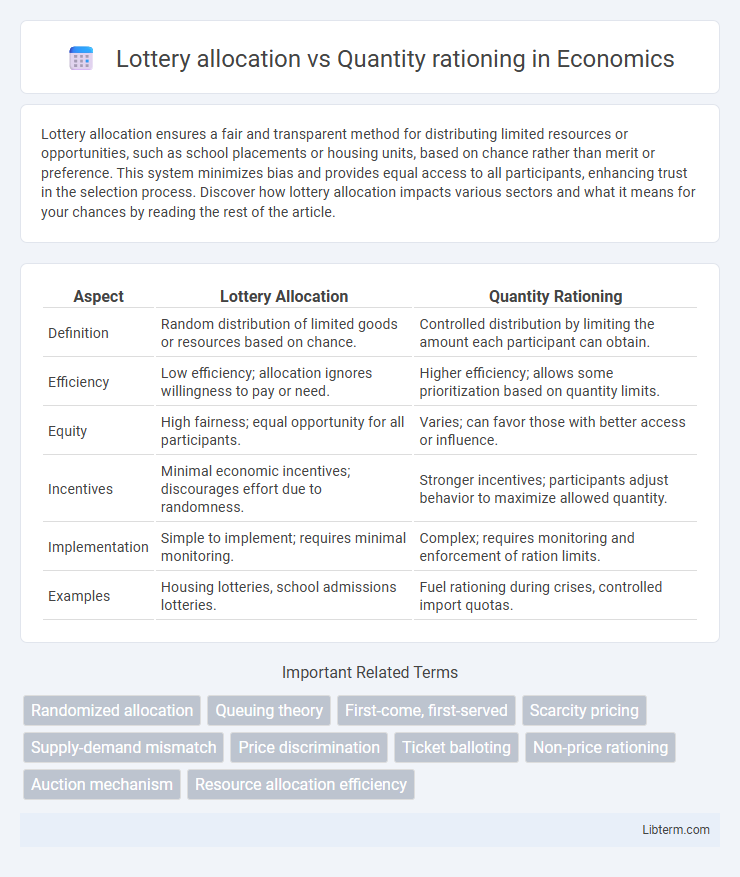Lottery allocation ensures a fair and transparent method for distributing limited resources or opportunities, such as school placements or housing units, based on chance rather than merit or preference. This system minimizes bias and provides equal access to all participants, enhancing trust in the selection process. Discover how lottery allocation impacts various sectors and what it means for your chances by reading the rest of the article.
Table of Comparison
| Aspect | Lottery Allocation | Quantity Rationing |
|---|---|---|
| Definition | Random distribution of limited goods or resources based on chance. | Controlled distribution by limiting the amount each participant can obtain. |
| Efficiency | Low efficiency; allocation ignores willingness to pay or need. | Higher efficiency; allows some prioritization based on quantity limits. |
| Equity | High fairness; equal opportunity for all participants. | Varies; can favor those with better access or influence. |
| Incentives | Minimal economic incentives; discourages effort due to randomness. | Stronger incentives; participants adjust behavior to maximize allowed quantity. |
| Implementation | Simple to implement; requires minimal monitoring. | Complex; requires monitoring and enforcement of ration limits. |
| Examples | Housing lotteries, school admissions lotteries. | Fuel rationing during crises, controlled import quotas. |
Introduction to Lottery Allocation and Quantity Rationing
Lottery allocation refers to distributing scarce resources randomly among eligible individuals when demand exceeds supply, ensuring fairness without prioritizing any specific group. Quantity rationing involves limiting the amount of a product or resource each person can obtain during shortages to manage supply efficiently and prevent hoarding. Both methods serve as mechanisms to address scarcity but adopt different approaches: randomness for equitable access and controlled limits for demand management.
Defining Lottery Allocation Systems
Lottery allocation systems distribute scarce resources or opportunities by randomly selecting recipients, ensuring fairness when demand exceeds supply. This method contrasts with quantity rationing, where fixed portions or quotas are assigned based on predetermined criteria or need. Lottery allocation promotes equal chances without bias, making it widely used in organ transplants, school admissions, and housing allocations.
Understanding Quantity Rationing Mechanisms
Quantity rationing mechanisms determine the allocation of limited goods by setting fixed amounts each participant can purchase, ensuring controlled distribution and preventing market shortages. Lottery allocation randomly assigns goods or services, offering a chance-based solution that avoids bias but may lead to inefficiencies in meeting demand. Understanding the differences between quantity rationing and lottery allocation highlights how controlled supply limits versus probabilistic access impact fairness and resource utilization.
Historical Applications of Lottery Allocation
Lottery allocation historically served as a fair mechanism in resource distribution during crises, such as wartime food rationing in World War II Britain and housing assignments in ancient Athens. This method prevented bias and corruption by relying on random selection when demand exceeded supply, ensuring equal chances for all participants. The enduring use of lottery allocation highlights its effectiveness in managing scarcity in diverse socio-economic contexts.
Efficiency Comparison: Lottery Allocation vs Quantity Rationing
Lottery allocation creates random distribution, often leading to inefficient resource use due to mismatch between demand and allocation. Quantity rationing directly limits supply, promoting strategic use but risking black markets and hoarding, which can also reduce efficiency. Empirical studies indicate quantity rationing typically achieves higher allocative efficiency by aligning distribution closer to actual demand patterns.
Fairness and Equity: Which Method Prevails?
Lottery allocation ensures fairness by giving all participants an equal chance regardless of background, promoting equity through randomness and impartiality. Quantity rationing allocates resources based on predetermined criteria, which can favor certain groups but may introduce bias and reduce perceived fairness. In terms of fairness and equity, lottery allocation often prevails by minimizing systemic advantages and providing uniform opportunity across diverse populations.
Administrative Complexity and Implementation Costs
Lottery allocation minimizes administrative complexity by relying on random selection mechanisms, reducing the need for detailed eligibility assessments or prioritization criteria. Quantity rationing, in contrast, often requires extensive monitoring, verification processes, and enforcement to ensure fair distribution within set limits, leading to higher implementation costs. Consequently, lottery systems offer a cost-effective solution with streamlined administration compared to the resource-intensive nature of quantity rationing.
Real-World Case Studies and Examples
Lottery allocation methods have been effectively used in housing markets during severe shortages, such as New York City's affordable housing lotteries, ensuring equitable access amidst high demand and limited supply. Quantity rationing has been implemented in healthcare, notably during the COVID-19 pandemic, where ventilator distribution was limited based on medical need and availability, prioritizing patients with the highest survival probability. Both approaches highlight distinct strategies in resource distribution under scarcity, with lotteries promoting fairness and rationing emphasizing efficiency based on criteria.
Impact on Consumer Behavior and Market Outcomes
Lottery allocation introduces randomness in resource distribution, which can increase perceived fairness but may reduce consumer motivation to participate actively, potentially dampening demand fluctuations. Quantity rationing restricts supply directly, often leading to heightened scarcity signals that elevate consumer urgency and willingness to pay higher prices, influencing market equilibrium. Both mechanisms shape market outcomes differently: lotteries can stabilize demand by equalizing chances, while rationing often tightens market supply, intensifying competition and price volatility.
Policy Recommendations and Future Directions
Policy recommendations for lottery allocation emphasize enhancing fairness and transparency to mitigate biases in resource distribution, while quantity rationing policies focus on optimizing supply chain efficiency and demand forecasting to reduce scarcity effects. Future directions suggest integrating advanced data analytics and behavioral insights to tailor allocation mechanisms to diverse populations and evolving market conditions. Emphasizing ethical frameworks and stakeholder engagement can improve acceptance and effectiveness of both allocation strategies.
Lottery allocation Infographic

 libterm.com
libterm.com